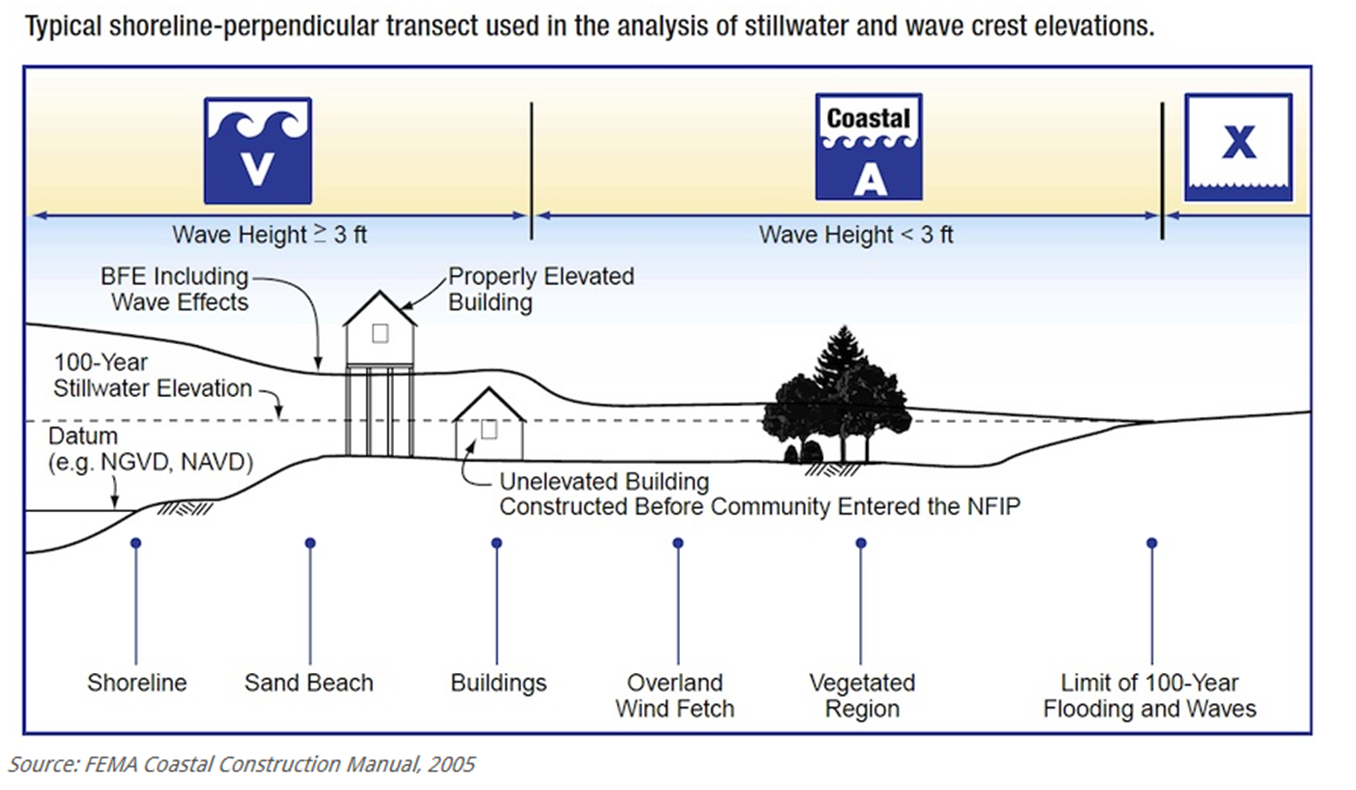[author: Michael Rimoldi]
Introduction
Flooding is the most common natural disaster in the United States, with every state having experienced some aspect of it in recent years1. Storm surge flooding, which occurs particularly in coastal areas as the result of offshore winds from tropical storms, has great potential to impact both personal safety and property.
This article will examine flooding and storm surge, identifying their unique characteristics as well as measures that are taken to help protect both people and property from their effects. First, we will address the difference between general flooding and storm surge flooding. While they both involve water, their characteristics—including when and where they typically occur—are quite different.
Flooding Versus Storm Surge
While both phenomena involve large and problematic amounts of water moving into spaces where it is not desired, flooding and storm surge are distinct from one another.
Flooding can occur anywhere where topography and drainage patterns—both natural and human made—cannot efficiently move and store water away from development or other undesired areas. Flooding is often assumed to occur near bodies of water such as lakes, rivers, and streams. While this is true, it can also occur in low lying areas with no year-round body of water present. Heavy rains can be a contributing factor, and this can surprise residents of areas where no immediate source of water is present, and where flooding is not expected.
In contrast, storm surge occurs in coastal areas, within immediate proximity of large bodies of water such as oceans, bays, and gulfs. Tropical storm activity in the form of hurricanes and cyclones pushes the water inland as the storm moves toward shore.
Wave action is notably characteristic of storm surge. This hydrodynamic force of water, taking the form of waves, causes danger to people in its path and can damage structures impacted by waves as they come ashore. Not to be confused with the waves of a tsunami, storm surge waves do not have to be large to cause damage. In fact, they may not be any larger than normal tidal and high wind waves typically seen offshore. However, they are capable of great impact as they move farther inland and produce sustained, repetitive, damaging force. A typical tropical storm might sit over a coastal area for several hours or even a day, and the resulting repetitive wave action can damage buildings if they are not constructed to resist the force.
Flood Zones Versus Evacuation Zones
A flood zone is the area typically identified on a National Flood Insurance Rate Map (FIRM), prepared by FEMA, which illustrates an area that can experience flooding at any time of the year (and typically due to high rainfall). This is exclusive of tropical storms or other such events. These zones are used to identify flood insurance and the elevation requirements of buildings within the flood zones identified on the maps. These maps can be found on the FEMA Map Services Center web page (https://msc.fema.gov/portal/home).
Evacuation zones are those areas mapped by the National Hurricane Center that will experience storm-driven waves, better known as storm surge, during a weather event. These areas are identified as those to be evacuated by residents before a tropical system makes landfall to ensure their personal safety. Local emergency management departments have this zone information readily available for residents. It is often referred to in public awareness campaigns such as “Know Your Zone.”
Protective Measures for Buildings Constructed in Flood & Evacuation Zones
The first step in taking action to protect both yourself and property from flooding and storm surge is to know the applicable flood and evacuation zones for your address. Flood zones can be identified by the online information at the FEMA Map Service Center, and storm surge information, in the form of evacuation zone identification, can often be found in your local community emergency management department. Some state emergency management departments have this information available at the statewide level as well.
It is important to understand a property could be in a flood zone and NOT be in the evacuation zone. Evacuation zones are primarily near the coast but can be adjacent to larger waterways as they move inland. Do the research now to make these determinations and do not wait until storm season to know your local zones.
Protecting Buildings in Flood Zones
As for protecting structures, buildings within flood zones such as Zone A (and even the lower risk Zone X) can be better protected by being elevated above the expected flood level, referred to as Base Flood Elevation (BFE). Existing buildings, while harder to elevate, can gain some benefits from the installation of hydrostatic vents if the foundation system allows for it. Non-residential buildings can also be floodproofed using flood shields and other floodproofing measures.

Figure 1
Protecting Buildings in Evacuation Zones
Buildings within the evacuation zone may also lie within flood Zone V or the velocity zone. The V Zone is characterized by having waves over 3 feet in height. This wave height is common to both storm surge in flood Zone V and in the evacuation zone, making it easy to remember (see Figure 1, above).
Construction in the V Zone requires special engineering and design measures to resist the forces of wave action, resist storm surge, and resist associated impacts such as scour and waterborne debris. These measures can be addressed more readily during new construction, but some mitigation measures are also achievable to an existing structure
References
[1] The National Severe Storms Laboratory (NSSL). Severe Weather 101: Flood Basics. Retrieved from: https://www.nssl.noaa.gov/education/svrwx101/floods/